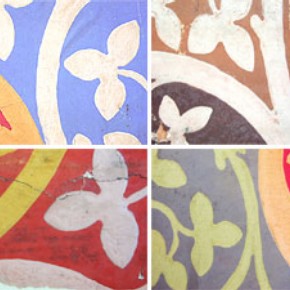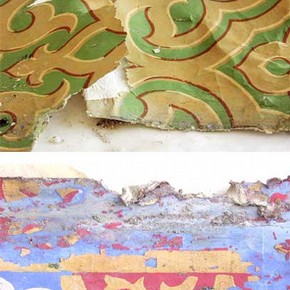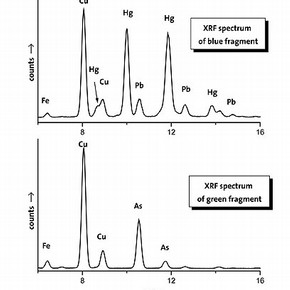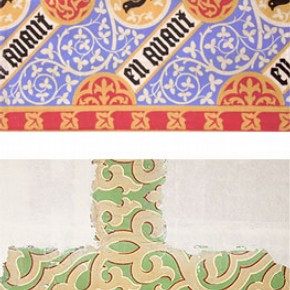Conservation Journal
Summer 2005 Issue 50
Pugin's wallpapers from The Grange
In April 2004, The Landmark Trust offered the Victoria and Albert Museum a rare opportunity to take samples of wallpapers from The Grange, in Ramsgate, Kent. This house was originally designed for and by A.W.N. Pugin incorporating one-off designs of floor tiles, stained glass and wallpaper, featuring his personal emblem, a bird. Some of the wallpapers were discovered beneath later paneling, skirting and door architraves and provide evidence of many coloured waves including the inscription 'en avant' as well as a more geometric design found underneath a bell pull frame. The house will eventually be used for recreational lettings and whilst being fully documented, certain fragments were considered as sacrificial since they would be lost during the building work. With the help of Merryl Huxtable, Senior Paper Conservator at the V&A, we spent a very cold day removing fragments to be conserved by Paper Conservation. The pigments on some of the fragments were also investigated using a combination of complementary scientific techniques, described below, with the aim of determining if toxic pigments were present and whether a possible date for the wallpapers could be suggested (Figure 1).
Each wallpaper fragment had been adhered with a starch-based paste onto a cream, machine-made lining paper, which in turn had been adhered to a wall covered with lime plaster embedded with horse hair. The blue 'en avant' design had been adhered to an external wall and consequently had suffered the most damage, having been weakened by water penetration and by the addition of iron posts to secure the later paneling. The right section was mouldy, and also showed signs of extensive flaking of the paint as well as shattering of the paper substrate. Conversely, the green geometric wallpaper was so well adhered to an internal wall that all day was required to release it. Some of the underlying plaster was also removed with it. The paint was flaking and gloss household paint was found at the edges. Both fragments had surface dirt, tears, missing areas and pigments that required further investigation (Figure 2).
Initial cleaning was kept to a minimum with the use of a soft brush to remove particulate dirt and a shaped chemical sponge on the non-friable areas. All the wallpapers were printed with a distemper onto a distemper-coated, machine-made, cream paper.1 The two printed surfaces were not well keyed together and the top design appeared to be lifting off. This was not helped by the change in humidity conditions from a damp environment at The Grange, to a relatively dry conservation studio at the V&A, which may have contributed to the breakdown of the proteinaceous medium of the distemper. Consolidation treatments included looking at the use of methylcellulose, hydroxyl-ethyl-propyl-cellulose and funori. Funori, a consolidant made from Japanese seaweed, was selected because of its good penetration, reversibility in water and matt appearance on drying. A 3% w/v funori solution was made using 6g of seaweed sheet previously rinsed to remove excess salts and soaked overnight in 200ml cold water. This was then simmered for twenty minutes, cooled and strained through polyester gauze. The pH of the resulting solution was 8.5.
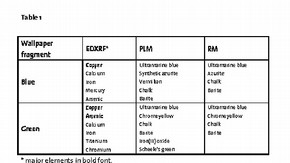
Table 1: Results of the scientific analysis of the Pugin wallpaper fragments (click image for larger version)
Fragments of the wallpaper were investigated by a combination of complementary scientific techniques, i.e. energy-dispersive X-ray fluorescence analysis (EDXRF), polarized optical microscopy (PLM) and Raman microscopy (RM), in order to determine if the fragments contained arsenic or other heavy metals and therefore constituted a health hazard; the wallpaper fragments were also analysed to identify all the pigments present and assist in dating the wallpaper (Table 1).
EDXRF was chosen as it is a non-destructive, non-intrusive technique which reveals the elemental composition of the objects analysed by it, and it is particularly suited for the detection of heavy metals. PLM, a technique used traditionally in the investigation of pigments and artists' materials, was used to examine the optical properties of the pigments on the wallpaper fragments. Raman microscopy has only recently started to be used on a routine basis in museums and heritage institutions and is particularly suited for the non-destructive, non-intrusive analysis of pigments and some dyes. One of its main advantages is that it provides a fast and unambiguous identification of the materials analysed.EDXRF analyses revealed that arsenic was present on the green wallpaper fragment (Figure 3). Raman and optical microscopy analysis of the same fragment identified synthetic ultramarine blue, chrome yellow, and the white pigments chalk and barite (Figure 4). A pale green pigment was probably the arsenic-containing Scheele's green. The blue fragments were found to contain synthetic azurite, synthetic ultramarine blue, chalk, barite and vermilion.
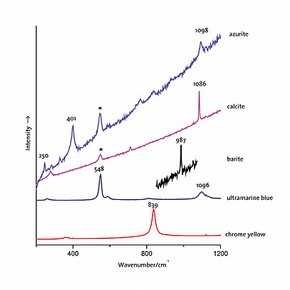
Figure 4: Raman spectra of pigments found on the Pugin wallpaper fragments (click image for larger version)
Because of the fragile and toxic nature of the pigments it was decided that the consolidation and lining would be carried out as a single operation. The wallpaper was initially humidified using the capillary matting/Gore-Tex™ method and then laid recto side up onto a piece of melinex (mic 125) as a support.2 Rayon paper was laid over the surface to face the object and warm funori was brushed through with a soft brush.3 The temperature of the solution was kept below 50°C as any higher would result in the loss of adhesion. Polyethylene was then placed over the top to facilitate moving the object prior to and during lining. The wallpaper was turned over, recto side down, and the polyethylene underneath stretched onto the table. The removal of the existing cream, machine-made lining paper was carried out after spraying with tap water and peeled off with the help of a bamboo spatula.
A lining of Japanese Sekishu paper was applied immediately using wheat starch paste. Borders were attached and the object was placed recto side up onto felts for drying. The polyethylene and rayon paper were carefully peeled back separately. After the initial drying period the borders were trimmed and the lined wallpaper re-humidified before being attached to the kari bari board and left for at least two weeks to dry. Infilling was carried out whilst the wallpaper was still on the board using archival text toned with watercolour and Carbothello pastel pencils and adhered with wheat starch paste. The use of pastel pencils allowed the matt chalky surface to be recreated. It was decided that areas of considerable loss would not be restored, as it was difficult to replicate the design, so a compatible colour was used (Figure 5). Storage prior to acquisition was provided by a deep covered mount to protect the chalky surface of the wallpaper.
These unique wallpaper fragments will now become a valuable addition to the V&A collection. The presence of poisonous heavy metals such as arsenic, mercury and chromium in a friable distemper dictated the method of treatment which was a combination of overall consolidation and lining in one operation using funori as the consolidant. This allowed minimal handling and disturbance of the surface of the wallpapers. Any future handling of the Pugin wallpaper should be undertaken with caution. The presence of synthetic ultramarine blue on both wallpaper types, dates the wallpaper to sometime after 1828.
References
1. Distemper, from the French 'détrempe'. There is still some confusion about this term, which in this case means a pigment in a proteinaceous medium.
2. Singer, H., Th¡e Conservation of Parchment Objects using Gore-TexTM Laminates, 'The Journal of the Institute of Paper Conservation', 16 (1992)
3. Rayon paper comprises of 15% rayon and 85% chemical wood pulp. Supplied by Mizakawa, Japan.
Acknowledgments
The authors are grateful to The Landmark Trust for providing the V&A with the opportunity of sampling the wallpapers and to Professor Robin J.H. Clark, University College London, for the use of his Renishaw Raman spectrometer.
Summer 2005 Issue 50
- Editorial
- Rising damp - a history of the Conservation Department
- V&A Conservation on the world wide web: a secondment to the V&A web team
- The ethics checklist - ten years on
- Plastics preservation at the V&A
- Working for Diaghilev
- Pugin's wallpapers from The Grange
- Prevention is better than the cure
- Research
- The Castellani diadem
- In pursuit of a clear answer: An Exhibition Road partnership
- Investigation of the room temperature corrosion of replica museum glass
- Professional collaboration - the Prince of Wales Museum of Western India
- V&A/RIBA partnership
- Picture and mirror frames: Reflections on treatment past, present and future
- A simple solution?
- Appendix 1: Victoria & Albert Museum Conservation Department Ethics Checklist
- Conservation of a tortoiseshell book cover
- The hand that rocks the cradle: Conservation administration, present and future
- Printer friendly version
